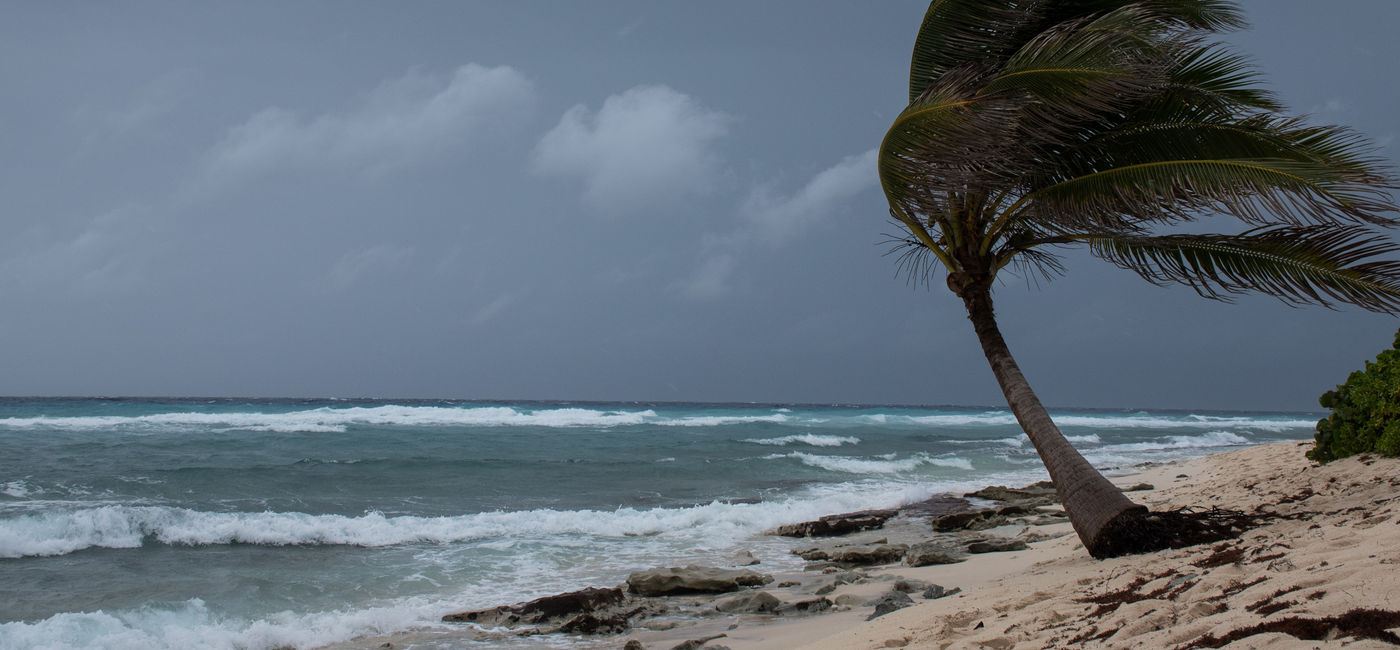- U.S.A English
- Canada English
- Canada Quebéc Francoís

Hurricane Lee on Track to Disrupt Travel

Update: September 11, 2023 at 10:46 a.m. ET
Hurricane Lee weakened significantly on Saturday from its maximum strength as a Category 5, but restrengthened back into a major Category 3 hurricane late Sunday and remained at that intensity on Monday, according to National Hurricane Center .
Weather.com experts tracking the storm said Hurricane Lee will begin to move northward in the Atlantic Ocean later this week, bringing rain, wind and coastal flooding to Bermuda, Atlantic Canada and eastern New England, but the forecast remains uncertain.
5pm AST Sun Sep 10th Key Messages for #Hurricane #Lee . Hazardous beach conditions to spread across the western Atlantic this week. Too soon to know level of impacts for US East coast or Atlantic Canada late this week, so stay tuned for updates. https://t.co/w5INoaj9KX pic.twitter.com/NaXXHp21Mz — National Hurricane Center (@NHC_Atlantic) September 10, 2023
While airlines have yet to start issuing travel waivers as they wait to see if and where the storm is expected to make landfall, cruise lines serving the Caribbean have been forced to alter itineraries and will continue to do so as Hurricane Lee cuts through the region.
Impacted cruise lines include Carnival Cruise Line, Royal Caribbean International and Disney Cruise Line.
UPDATE: Friday, September 8 at 5:15 p.m. ET
Hurricane Lee weakened slightly on Friday but remains a powerful Category 4 storm with maximum sustained winds of 155 mph as it tracks westward about 550 miles east of the northern Leeward Islands.
For now, it's still early to know if and where Lee could make landfall in the Caribbean and mainland U.S.
UPDATE: Friday, September 8 at 8:15 a.m. ET
Hurricane Lee is currently a Category 5 storm with maximum sustained winds of 165 mph as it tracks westward toward the Caribbean. "Additional strengthening is forecast today. Fluctuations in intensity are likely over the next few days, but Lee is expected to remain a major hurricane through early next week," the National Hurricane Center said in an early morning update. It's still too early to know Lee's exact track as there are several steering factors that could send it out to sea or bring it closer to the mainland U.S., Bermuda and other destinations.
Hurricane Lee could potentially wreak havoc on shoulder season travel in the Caribbean and Southeastern United States in the coming days as it rapidly intensified Thursday and developed into a major Category 5 storm, the National Hurricane Center said. The Category 5 storm now has maximum sustained winds of 160 mph and forecasters are growing more confident that the center of the storm will pass to the north of the northern Leeward Islands, the Virgin Islands and Puerto Rico as early as this weekend and into early next week. Tropical storm conditions are possible for some of those island destinations over the weekend. The British and U.S. Virgin Islands as well as Puerto Rico, Hispaniola, the Bahamas and Bermuda could see significant swells from Lee in the coming days, resulting in life-threatening surf and rip current conditions, experts warn. It's too soon to know whether Lee will snarl travel or significantly impact the mainland U.S. At this point, airlines have yet to issue travel waivers but travelers are always encouraged to check their flight status with their airline prior to arriving at the airport.
For the latest travel news, updates and deals, subscribe to the daily TravelPulse newsletter .
Topics From This Article to Explore
Related videos.

Island Fun Awaits in Montego Bay

Enjoy Low Season in Italy

Industry Takeaways From 2024 Future Leaders in Travel Retreat

Updates From Dominican Republic Tourism’s Rebeca Del Pino
Editor's picks.
Contiki Unveils New European and Peruvian Itineraries, Exclusive Launch Deal
Explora Journeys Appoints Anna Nash as President
American airlines offering round-trip flights to europe for under $500, connecticut counters florida’s removal of lgbtq+ travel info with inclusive tourism campaign, featured video, epic journeys await in shannon, related offers.

Celestyal's Group Blitz

Bonus Cash: Up to $125 Added Commission for Every Room
Featured blogs.

Plan Your Ideal Last-Minute Holiday Vacation With Exclusive Options From Villas of Distinction

Experience Unparalleled Sophistication at The Rooftop: Riu Plaza Chicago Hotel
Featured podcast.

Boeing 737 MAX

Virtual Travel

New Openings

Patrick Clarke
Senior editor.
Editor Senior Editor true [email protected] _pat_clarke 9268 14744 A Maryland native and wanderer who has lived across the U.S. from North Carolina to SoCal, Patrick Clarke graduated from Towson University with a B.S. in journalism. He previously worked for Bleacher
Atlantis Resorts Appoints Paul Baker as President
Aurora expeditions names greg cormier chief marketing officer, interactive map reveals the best time to experience fall foliage across the us, the can't-miss travel deals for september 2024, sponsored content, impacting travel suppliers, latest blogs.

Villas of Distinction Blog
The social jet-setter experience: revolutionizing travel advisor training, exploring barrancas del cobre park: a thrill-seeker’s paradise, latest news.

Tour Operator
Latest videos.

Hotels and Resorts
Become a travel expert.

Get To Know Us Better
Plan a legendary vacation.
Explore the latest travel news, advice, updates, upcoming exclusive deals and more.

Helping leisure selling travel agents successfully manage their at-home business.
Agent specialization: group travel.

Laurence Pinckney
CEO of Zenbiz Travel, LLC
- Share full article
Advertisement
Tracking Post-Tropical Cyclone Lee
By William B. Davis , Madison Dong , Judson Jones , John Keefe and Bea Malsky Sep. 5, 2023
Lee was a post-tropical cyclone in the Gulf of Saint Lawrence with sustained wind speeds of 45 miles per hour, the National Hurricane Center said in its latest advisory. Follow our coverage here .
Lee is the 12th named storm to form in the Atlantic in 2023.
In late May, the National Oceanic and Atmospheric Administration predicted that there would be 12 to 17 named storms this year, a “near-normal” amount. On Aug. 10, NOAA officials revised their estimate upward, to 14 to 21 storms.
There were 14 named storms last year, after two extremely busy Atlantic hurricane seasons in which forecasters ran out of names and had to resort to backup lists. ( A record 30 named storms formed in 2020 .)
This year features an El Niño pattern, which arrived in June. The intermittent climate phenomenon can have wide-ranging effects on weather around the world, and it typically impedes the formation of Atlantic hurricanes.
In the Atlantic, El Niño increases the amount of wind shear, or the change in wind speed and direction from the ocean or land surface into the atmosphere. Hurricanes need a calm environment to form, and the instability caused by increased wind shear makes those conditions less likely. (El Niño has the opposite effect in the Pacific, reducing the amount of wind shear.)
At the same time, this year’s heightened sea surface temperatures pose a number of threats, including the ability to supercharge storms.
Sources and notes
Tracking map Source: National Hurricane Center | Notes: Map shows probabilities of at least five percent. The forecast includes the five days starting up to three hours before the storm’s latest reported time and location.
Arrivals table Sources: New York Times analysis of National Hurricane Center data (arrival times); U.S. Census Bureau and Natural Earth (geographic locations); Google (time zones) | Notes: The table shows predicted arrival times of sustained, tropical-storm-force winds of 39 miles per hour or greater at selected cities if there is a chance such winds could reach those locations. “Earliest possible” times are times when, if tropical-storm-force winds do arrive, there is at least a 10 percent chance they will arrive at the time shown. “Most likely” times are times when, if tropical-storm-force winds do arrive, there is an equal chance that such winds will arrive before and after the time shown.
Explore Our Weather Coverage
Extreme Weather Maps: Track the possibility of extreme weather in the places that are important to you .
Heat Safety: Extreme heat is becoming increasingly common across the globe. We asked experts for guidance on how to stay cool .
Hurricane Preparation: When a storm is approaching, you may not have much time before you must head for safer ground. Here are some tips for getting ready .
Tornado Alerts: A tornado warning demands instant action. Here’s what to do if one comes your way .
Flash Flooding: Fast rising water can be deadly. Here’s what to do if you’re caught off guard , and how to prepare for a future flooding event.
Evacuating Pets: When disaster strikes, household pets’ lives are among the most vulnerable. You can avoid the worst by planning ahead .
- Skip to main content
- Keyboard shortcuts for audio player
Lee is a hurricane now and will be a 'major' storm soon — with 155 mph winds or more

Russell Lewis

This National Hurricane Center graphic, produced at 10 p.m. ET on Wednesday, Sept. 6, 2023, shows the projected path and strengthening of Hurricane Lee as it moves across the Atlantic Ocean. Credit: NOAA/National Hurricane Center hide caption
This National Hurricane Center graphic, produced at 10 p.m. ET on Wednesday, Sept. 6, 2023, shows the projected path and strengthening of Hurricane Lee as it moves across the Atlantic Ocean.
Lee has strengthened into a hurricane in the Atlantic Ocean and forecasters say it's expected to grow rapidly into a major hurricane by this weekend.
In its last advisory , the National Hurricane Center said Lee has winds of 80 mph and is moving toward the Leeward Islands. Forecasters are already using stark language about the storm and its prospects.
"It is becoming a question of when and not if rapid intensification occurs with Lee," the advisory noted. Winds are forecast to reach 155 mph which is a high-end Category 4 'major hurricane' with the possibility of "explosive intensification."

The Picture Show
Photos: see the aftermath of hurricane idalia.

Hurricane Lee is rapidly intensifying, and it's forecast to be a Category 5 storm
This already is a 15 mph increase from the NHC's initial advisory on Tuesday. The reason for the higher wind speed is the above-average water temperatures in the area of the Atlantic the storm is churning through. "The system should be moving over record-warm waters ... east of the Lesser Antilles." Forecasters say those kinds of water temperatures are what they typically see in the Gulf of Mexico — not in the much cooler ocean.
This forecast — so far out in the Atlantic — with a prediction of strengthening this quickly is unusual . Still, it's too early to say with any certainty exactly where this storm will go.
Vast majority of tracks for eventual Major Hurricane Lee are clustered into a "recurve" scenario well away from the U.S. East Coast. However, there are indeed some outliers that have a mind of their own. Until the rest join the outliers or the whole envelope of solutions drifts… pic.twitter.com/1I8eLYnO5t — Ryan Maue (@RyanMaue) September 5, 2023
Most of the long-range models have Lee eventually curving north - missing the Caribbean and remaining offshore of the United States. While models are generally accurate, they're not perfect. Hurricane Irma , in 2017, was supposed to follow a similar path - but instead walloped the Gulf coast of Florida.
Even if Lee misses land, forecasters say swells generated by Lee "are expected to reach portions of the Lesser Antilles on Friday, and the British and U.S. Virgin Islands and Puerto Rico this weekend. These swells are likely to cause life-threatening surf and rip current conditions."
Lee is the the 13th named storm of what is an above-average Atlantic hurricane season. As researcher Phil Klotzbach notes, only "4 other years on record have had 13+ Atlantic named storms by Sept. 5: 2005, 2011, 2012, 2020."
- 2023 Atlantic Hurricane Season
- Tropical Storm Lee
clock This article was published more than 1 year ago
Hurricane Lee restrengthens to Category 3. Here’s what’s next.
The storm rapidly intensified, then rapidly weakened, and is strengthening yet again

Hurricane Lee has taken meteorologists for a wild ride. On Thursday, it was barely a hurricane. By Friday, it had blown up into a Category 5, becoming the third-most rapidly intensifying storm ever observed in the Atlantic Ocean. Then it weakened equally quickly. Now, it’s strengthening yet again and has regained major hurricane status as a Category 3. Its peak winds leaped Sunday from 105 to 120 mph, and it is forecast to intensify back to a Category 4 on Monday.
While the forecast for where Lee might end up is uncertain, the risk of a direct hit to the Canadian Maritimes around next weekend is increasing. There’s a slight risk that the northeastern United States could face a close shave as Lee whirls nearby or just offshore.
It’s barely a week until the historic peak of hurricane season in the Atlantic, which falls in mid-September. By October, fewer storms form over the open Atlantic as stronger upper-level winds become more hostile to storm development. Instead, the threat shifts to “homegrown” tropical systems — those that form in the Gulf of Mexico or in the Caribbean Sea.
Heading into the 2023 Atlantic hurricane season, experts predicted that record-warm ocean waters would tip the scales toward an anomalously active season. That’s been the case to date, and there’s no reason to expect the ocean basin to simmer down anytime soon.
A first: Category 5 storms have formed in every ocean basin this year
Where is Hurricane Lee and how strong is it?
As of Sunday at 5 p.m., Lee was centered about 285 miles north-northeast of the Northern Leeward Islands and was moving west-northwest at 8 mph. Winds were estimated at 120 mph.
Lee’s increase in strength was tied to the following:
- “Hot towers,” or tall thunderstorms, were orbiting Lee’s center or “eye,” which was becoming better defined.
- Hostile wind shear — or changing winds with altitude which disrupt thunderstorm development — had eased.
- The air pressure inside Lee had decreased. That meant a more powerful vortex and stronger inward suction, increasing winds.
- A new eyewall or ring of intense thunderstorms around the storm center was apparent on microwave infrared imagery, which is a special satellite product that allows meteorologists to peer “under the hood” at Lee’s inner structure.
Where is Lee likely to hit?
Lee is going to continue drifting west-northwest. In coming days, it will make a turn to the north, but where exactly it makes that turn remains to be seen.
The storm will be steered north between two weather systems spinning in opposite directions. Over the open Atlantic, a blocking high pressure “ridge” is spinning clockwise. Over the eastern United States, a counterclockwise-spinning “trough” of low pressure will be present. Lee should be shuttled between them and scooped north, but uncertainties in the projected strengths and positions of both steering systems mean we don’t know yet how close to the East Coast the storm will track.
If the track shifts eastward, Bermuda could be in play, too, for at least a fringing, or possibly more direct effects. That would be in the Wednesday-to-Thursday time frame.
New England — especially eastern New England and Downeast Maine — should keep tabs on the system, particularly late this week into the weekend. At least one run of the European model depicted a direct hit to Cape Cod, but that is an outlier scenario.
The most likely scenario still calls for a hit in the Canadian Maritimes. By then, Lee would probably be a nontropical storm but would be just as strong as a hurricane. With a broader wind field, significant surge would be possible, in addition to wind and flooding rains.
Regardless of where Lee heads, the eastern coastline of North America, as well as the Northern Leeward Islands, Virgin Islands, Puerto Rico, Turks and Caicos, and the Bahamas, can expect rough surf and dangerous rip currents.

When might Hurricane Lee make landfall?
The majority of weather models keep Lee’s center offshore of the United States. Assuming it does make landfall in the Canadian Maritimes, it would be in about seven to eight days.
How strong will Lee get?
Lee is projected to become a Category 4 on Monday and remain that intense on Tuesday before slowly weakening as it moves over cooler waters during the second half of the week.
How strong will Lee be when it nears land?
When Lee passes Bermuda, it will probably be a Category 1 or low-end Category 2 storm. Fortunately, it should remain just offshore, sparing Bermuda any direct hit, though tropical storm conditions are possible.
By next weekend, the most likely scenario, though teeming with uncertainty, is for Lee to be a strong Category 1 — or perhaps Category 2-equivalent storm — as it approaches Canada’s maritime provinces. It’s not clear whether it will be fully tropical, but it’s very probable that Lee’s winds will reach farther from the storm’s center. That could bring tropical storm conditions to a much wider swath of coastline.
What do computer models project for Lee?
We can look at a “spaghetti ensemble” plot that captures the range of possibilities with Lee. Darker shadings represent areas with more overlapping possible tracks — meaning a higher likelihood that Lee goes there. Less likely scenarios are in a lighter shading.
What has made Lee stand out?
#Lee 's life story, Chapter 1: From African easterly wave to sudden extreme intensification into a Category 5 #hurricane (wait for it) pic.twitter.com/1EWakTRkBe — Stu Ostro (@StuOstro) September 8, 2023
- Lee was the first Category 5 hurricane in the Atlantic this season. Since 2016, there have been seven others. One of them, Michael, made a U.S. landfall at Category 5 strength on Oct. 10, 2018.
- Lee also became the farthest southeast storm to achieve Category 5 status on record in the Atlantic.
- Moreover, Lee’s rapid intensification — spiking from an 80 mph Category 1 to an extreme 160 mph Category 5 in 24 hours — made it the most rapidly intensifying Atlantic storm on record outside the Caribbean, and the third-most swiftly strengthening Atlantic storm on record overall. Rapid intensification, while common with major hurricanes, is made more likely by the effects of human-induced climate change.
Are there any other Atlantic storms to worry about?
Elsewhere in the Atlantic, Tropical Storm Margot is midway between the coasts of South America and Africa. It had 50 mph winds early Sunday. On satellite, one could note that the bulk of the thunderstorms were located north-northeast of the low-level swirl, meaning the storm is vertically misaligned. That’s due to changing winds with height in the atmosphere known as “shear.” So long as shear is present, Margot will struggle to strengthen.
It will probably curve north-northwest and become a hurricane in coming days. By Thursday, it should be passing over the open ocean midway between Bermuda and the Azores.
How is this hurricane season stacking up?
Fourteen named storms have formed so far this season, including four hurricanes, three of which became major hurricanes. Activity perked up quickly in mid-August, with Franklin becoming a Category 4 over the open Atlantic and Idalia doing so over the Gulf of Mexico. Idalia eventually struck the Florida Big Bend as a high-end Category 2 or a low-end Category 3, then quickly weakened inland.
In terms of the number of systems, we’ve had more than is typical. Fourteen is sort of normal for an entire season, and we’ve already reached that at the midpoint. On average, a season’s fourth hurricane happens by mid-September, so we’re right on schedule there. That said, only three per year on average become major, and the average date of a season’s third major hurricane is Oct. 28 — meaning we are far outpacing what’s usual when it comes to forming major hurricanes.

Morning Rundown: Trump and Harris go head-to-head, Israel launches deadly strike on Gaza humanitarian zone, and lockdown's impact on teen brains
Storm tracker: Follow Hurricane Lee’s path
Hurricane Lee is a powerful storm churning through the Atlantic.
As of Monday afternoon, it measures a Category 3 storm with maximum sustained speeds of 115 mph.
Forecasts have the storm bringing strong winds, rainfall and surf toward Bermuda near the end of the week .
Follow the storm’s path on the map below. It will be updated frequently.
Nigel Chiwaya is the Senior Editor, Data Viz for NBC News Digital.
Hurricane Lee's latest forecast: Northeast to see dangerous rip currents, huge waves
The Carolinas to Long Island are seeing waves up to 12 feet.
There's an increasing likelihood that Hurricane Lee, now a Category 2 storm, will bring wind, rain and flooding to coastal New England on Friday and into the weekend.
As of Wednesday night, the National Hurricane Center reported that the storm was approximately 370 southwest of Bermuda and 950 miles south of Nantucket, Massachusetts.
Here's what you need to know:
MORE: Hurricane Lee becomes rare storm to rapidly intensify from Cat 1 to Cat 5 in 24 hours
Alerts for high surf and rip currents have been issued from Florida to Massachusetts.
MORE: How to escape from life-threatening rip currents
New York Gov. Kathy Hochul is sending 50 National Guardsmen to help Long Island prepare for the possible high surf, rip currents, coastal flooding and beach erosion.
On Wednesday night, the National Hurricane Center sent out an alert warning that tropical storm conditions were likely over Bermuda on Thursday.

Lee is forecast to still be hurricane-strength by the time it passes east of Cape Cod, Massachusetts, on Saturday morning.
Lee could bring strong, gusty winds from Rhode Island to Boston to Maine. The heaviest rain, wind and storm surge will be from Cape Cod to Bar Harbor, Maine, from Friday night through Saturday.
Hurricane conditions are possible in eastern Maine.
Up to 4 feet of storm surge is possible on Cape Cod and Nantucket.
Early Sunday morning, Lee may make landfall between coastal Maine and Nova Scotia as a post-tropical storm. Lee will then head out to sea.
Related Topics
Popular reads.

Suspect at large in freeway shooting
- Sep 8, 11:18 PM

How to watch the Harris-Trump ABC News debate
- 2 hours ago

Johnny Gaudreau's widow announces pregnancy
- Sep 9, 3:52 PM

Neighbor arrested in death of missing nurse
- Sep 7, 6:59 PM

4 dead in shooting at Georgia high school
- Sep 4, 10:47 PM
ABC News Live
24/7 coverage of breaking news and live events
Mountain View, CA
Mountain View
Around the Globe
Hurricane tracker, severe weather, radar & maps, news & features, winter center, news / hurricane, hurricane lee to restrengthen as accuweather forecasters outline impacts for us, canada.
Hurricane Lee will ramp up once again to a major hurricane over warm ocean waters. As Lee tracks northward in the coming days, impacts are expected in eastern New England and Canada.
By Alex Sosnowski , AccuWeather senior meteorologist
Published Sep 8, 2023 8:48 AM PDT | Updated Sep 11, 2023 5:58 AM PDT

AccuWeather meteorologists continue to track the path of Hurricane Lee as it churns north of the Caribbean. They say it will restrengthen to a major hurricane over the next day or so as it moves over abnormally warm ocean waters.
Hurricane Lee grew rapidly into a monster Category 5 hurricane churning over the Atlantic last Friday morning. It will remain a powerful and dangerous hurricane as it spins well north of the Leeward Islands on Sunday, prior to taking a northward turn along the East coast of the United States by the middle of this week. AccuWeather meteorologists warn that the threat of impacts in eastern New England is increasing, and much of the East Coast will experience high seas and dangerous surf.
Lee, which was named in the central Atlantic on Tuesday, was located about 340 miles north of the northern Leeward Islands of the eastern Caribbean on Monday morning. It was a Category 3 hurricane with maximum sustained winds of 120 mph. Changes in the structure of the eye were evident and some fluctuation in strength is likely from Monday to Tuesday.
Due to its mega strengthening from Thursday to Friday morning, becoming a Category 5 for a period of time, Lee holds the title of the strongest hurricane to churn in the Atlantic during the 2023 season.

Lee becomes a monster hurricane
Late last week, Hurricane Lee had undergone a rapid intensification. Early Friday morning, Lee reached top-tier Category 5 strength on the Saffir-Simpson Hurricane Wind Scale and packed 165-mph winds. Just 24 hours prior, it had been an 80-mph Category 1 hurricane. Rapid intensification occurs when a tropical system's sustained winds increase by 35 mph or more in 24 hours. Lee had more than doubled down on the criteria needed for rapid intensification, which is extremely rare.
GET THE FREE ACCUWEATHER APP
Have the app? Unlock AccuWeather Alerts™ with Premium+
In fact, only six other Atlantic hurricanes have strengthened by 80 mph or greater within a 24-hour period. According to Philip Klotzbach, a Colorado State University meteorologist, the other hurricanes that intensified at a similarly astounding pace include Eta in 2020, Maria in 2017, Matthew in 2016, Ike in 2008, Felix in 2007 and Wilma in 2005.

Category 5 Hurricane Lee late on Sept. 7, 2023.
“Wilma, from the 2005 mega hurricane season, holds the record for 24-hour rapid intensification in the Atlantic basin,” AccuWeather Senior Meteorologist Bill Deger said. “The system’s sustained winds ramped up 105 mph from a 70-mph tropical storm to a 175-mph Category 5 hurricane in 24 hours.”
Lee will be long-lived with fluctuations in strength
Lee has already traveled more than 1,600 miles since its birth over the west-central Atlantic early last week and will likely more than double that distance by this weekend.
The major hurricane will take a curved path around a large area of high pressure sitting over the central Atlantic, which will guide the powerful storm north of the northern islands of the Caribbean on Sunday, then northeast of the Bahamas, west of Bermuda and east of the southeastern United States into the first half of this week.

"Changes in Lee's eye structure will result in some fluctuation in the strength of the hurricane through this weekend," AccuWeather Chief On-Air Meteorologist Bernie Rayno said.
Rayno pointed out that Lee was so intense that it had been creating its own moist environment since Thursday -- a factor that can help powerhouse hurricanes maintain strength.
A phenomenon known as wind shear may also contribute to fluctuations in strength this weekend. Strong wind shear, or changing winds with altitude, can quickly tear apart organized tropical systems or make it more challenging for cyclones to develop. A lack of vertical wind shear is optimal for strengthening and tropical organization.
Hurricane Lee's forecast impacts on the US, Canada
From midweek on, the exact track of Lee will determine the scope of direct and indirect impacts in the eastern U.S. and Atlantic Canada. The slow forward speed of Lee for a time this week may cause the system to lose some wind intensity as cool water from the depths is churned to the surface. However, Lee will remain a powerful and dangerous hurricane.

"Starting as early as Sunday, seas and surf will build to dangerous levels along the central and northern coast of Florida and expand northward through the mid-Atlantic and New England coasts this week," AccuWeather Senior Meteorologist Joe Lundberg said.
The building surf will lead to frequent and strong rip currents, pounding waves, beach erosion and even coastal flooding at times of high tide. Breezy conditions are expected to spread along the Carolina coastline during the last half of this week.
AccuWeather forecasters have given an all-clear from the standpoint of a direct hit from Florida to North Carolina, which will prevent Lee's high winds and flooding rain from reaching areas recently hard-hit by Idalia.

However, by late last week, forecasters began to note that the risk of impacts was increasing farther north along the coast of North America from New England to the Canadian Maritime Provinces and the large Canadian island of Newfoundland.
AccuWeather forecasters are keeping a close eye on the future track of Hurricane Lee as the storm nears North America later this week into the upcoming weekend. At this point, forecasters think Lee will either make landfall somewhere from far eastern New England to Atlantic Canada.
As Lee approaches, the behavior of the jet stream will determine the extent of the direct impacts in the northeastern United States.

If the jet stream swings eastward and off the Atlantic coast at a swift pace, it should help to protect the mid-Atlantic from feeling direct rain and high winds from Lee. In this case, Lee would be pushed along and would avoid a direct hit on the U.S. but still would likely roll into Atlantic Canada.
However, if the jet stream hangs back, when combined with Lee's slow movement initially, the powerful storm could be pulled in close to the U.S. by steering winds during the middle and latter part of next week. In the latter scenario, there is the risk of a landfall in eastern New England with widespread risks to lives and property.
Forecasters are outlining primary impacts from Lee from southeastern Massachusetts on northeastward through Nova Scotia, areas of Newfoundland and Labrador. Higher impacts will be likely across southern and eastern Nova Scotia, particularly over the upcoming weekend.

"The area in the United States that really needs to pay attention is along the eastern coast of New England," Rayno said, adding that parts of Atlantic Canada are most likely to also get direct impacts from Lee by late week.
Even if the center of Lee remains offshore, heavy rain and strong winds are expected to reach parts of New England over the upcoming weekend. Lee's proximity to the coast will determine how severe conditions become in terms of damage from storm surge, high winds and torrential rain.
"What tends to happen as hurricanes move into northern latitudes during September and October is that the rain and wind fields tend to expand as the storm's top winds decrease," AccuWeather Director of Forecast Operations Dan DePodwin said. This is how a storm center passing a couple of hundred miles to the east can still bring heavy rain and/or strong winds to parts of the Northeast, depending on the weather pattern.

By next weekend, steering breezes relative to Lee will increase and cause the hurricane's forward speed to increase substantially.
Peak wind gusts from Lee ranging from 40-60 mph will be possible from Cape Cod, Massachusetts, to parts of Newfoundland and Labrador, with winds blowing upwards to 80-100 mph where the storm can make landfall across areas of southern Nova Scotia.
Forecasters urge offshore shipping, fishing and cruise interests to closely monitor the track of Hurricane Lee, which will generate massive seas. Deep sea swells could range from 30-40 feet and locally higher in the proximity of the powerful storm that is likely to remain a hurricane for an extended time in northern Atlantic waters. Swells of 10-20 feet may be as close as a few dozen miles offshore.
Heavy rain can spread from the border of Maine and New Brunswick through Nova Scotia and southern Newfoundland over the upcoming weekend as Lee tracks northward. A wide swath of 1-2 inches is expected across this zone, with 2-4 inches possible in western Nova Scotia as early as this Saturday.

AccuWeather was the first to initiate track maps for Lee prior to it becoming a named tropical system and the first to forecast it to become a Category 5 hurricane, some 24 hours ahead of the National Hurricane Center.
Margot to become Atlantic's 5th hurricane
Elsewhere in the Atlantic, Tropical Depression Fourteen formed near a group of islands off the west coast of Africa called the Cabo Verde Islands on Thursday midday and, hours later, was upgraded to Tropical Storm Margot.

Margot is likely to ramp up to a hurricane before the middle of this week. Once this system moves away from the Cabo Verde Islands, it is not likely to be a threat to land in the near future.
More to read:

Want next-level safety, ad-free? Unlock advanced, hyperlocal severe weather alerts when you subscribe to Premium+ on the AccuWeather app . AccuWeather Alerts ™ are prompted by our expert meteorologists who monitor and analyze dangerous weather risks 24/7 to keep you and your family safer.
Weather News

Insane lightning strikes captured in Florida

Warmth to build across the parched Plains

Line and Davis fires grow in California and Nevada, displacing thousan...
Accuweather early, hurricane center.
Top Stories
Trending Today
In memoriam, case studies, blogs & webinars.
Tropical Storm Francine to become hurricane before making landfall US
2 hours ago

5 reasons behind the historic absence of storms this hurricane season
21 hours ago

Weather Forecasts
17 hours ago

Residents flee as California and Nevada wildfires close in
23 hours ago

Major cooldown to erase heat across the West
5 hours ago

Featured Stories
AccuWeather debuts new show, 'Invisible Iceberg'
19 hours ago

US’ first human case of bird flu not linked to animals reported in Mis...

‘Remarkable’ ring buried for more than 1,000 years unearthed

Scientific discovery that turns mouse skin transparent echoes ‘The Inv...

Landslides are destroying multimillion-dollar homes in California
22 hours ago

We have updated our Privacy Policy and Cookie Policy .
Get AccuWeather alerts as they happen with our browser notifications.
Notifications Enabled
Thanks! We’ll keep you informed.
Watch CBS News
Hurricane Lee: New York City area update

IMAGES
COMMENTS
American Airlines, Southwest Airlines and United Airlines all offered travel waivers for passengers who have flights booked during the hazardous weather associated with Hurricane Lee. Flyers ...
Lee made landfall in Canada on Saturday as a post-tropical cyclone, bringing heavy rainfall, powerful winds and storm surge to parts of New England and southeastern Canada. Some flights and ...
Hurricane Lee weakened slightly on Friday but remains a powerful Category 4 storm with maximum sustained winds of 155 mph as it tracks westward about 550 miles east of the northern Leeward Islands. For now, it's still early to know if and where Lee could make landfall in the Caribbean and mainland U.S. UPDATE: Friday, September 8 at 8:15 a.m. ET.
Hurricane Lee's path and timeline: Meteorologists project ...
Tracking Post-Tropical Cyclone Lee
Powerful Hurricane Lee will create hazardous conditions ...
Hurricane Lee is expected to intensify into an "extremely dangerous" category four storm by the weekend, says the US National Hurricane Center (NHC). The Atlantic storm became a category two ...
Lee is a hurricane now and will be a 'major' storm soon — with 155 mph winds or more. This National Hurricane Center graphic, produced at 10 p.m. ET on Wednesday, Sept. 6, 2023, shows the ...
Lee hit a rare strength that few storms have ever achieved. Only 2% of storms in the Atlantic reach Category 5 strength, according to NOAA's hurricane database.
Lee was the first Category 5 hurricane in the Atlantic this season. Since 2016, there have been seven others. One of them, Michael, made a U.S. landfall at Category 5 strength on Oct. 10, 2018.
Hurricane Lee is a powerful storm churning through the Atlantic. As of Monday afternoon, it measures a Category 3 storm with maximum sustained speeds of 115 mph. Forecasts have the storm bringing ...
Lee is forecast to still be hurricane-strength by the time it passes east of Cape Cod, Massachusetts, on Saturday morning. Lee could bring strong, gusty winds from Rhode Island to Boston to Maine.
The National Hurricane Center's five-day forecast indicates Lee will continue moving west-northwestward on a track that takes it somewhere northeast of the Turks and Caicos Islands and the eastern ...
Lee struck Nova Scotia while packing 70-mph sustained winds on Saturday. As it crashed ashore, unleashing ferocious waves and damaging winds, at least one person was killed and thousands were left ...
Early Friday morning, Lee reached top-tier Category 5 strength on the Saffir-Simpson Hurricane Wind Scale and packed 165-mph winds. Just 24 hours prior, it had been an 80-mph Category 1 hurricane ...
As of Saturday evening, Lee was moving west-northwest ‒ roughly in the direction of the United States ‒ at 10 mph as a Category 3 hurricane. The storm is still hundreds of miles out to sea and ...
Hurricane Lee continues churn towards east coast of US ...
The storm is expected to impact travel in eastern New England and Atlantic Canada by the weekend. ... Hurricane Lee is a Category 1 storm making waves due to its massive size, with tropical storm ...
A map showing expected wave heights off New England on Saturday, Sept. 16, 2023, as Hurricane Lee impacts the area, including Massachusetts, New Hampshire and Maine.
Download Our App. Watch CBS News. Hurricane Lee: New York City area update. CBS New York's John Elliott breaks down the storm's latest track and timing, and what effects it will have in our area ...
LEE IMPACTS. Will be highest at the coast in terms of wind and rain. This is a LOW IMPACT event once you get west of 128. ️Wind gusts to 50mph at coast but near and over 60mph for the mid and ...
Travel. Climate. Now Playing. Hurricane Lee Grows Larger 00:54. Next Up. Watch: Ocean Trio Swim And Feast Together ... Watch: 'Labor Day Lift Off' Featuring Carnival Of Hot Air Balloons 00:30.